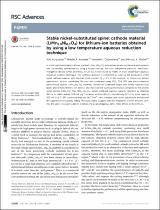 ResearchSpace
ResearchSpace
Stable nickel-substituted spinel cathode material (LiMn1.9Ni0.1O4) for lithium-ion batteries obtained by using a low temperature aqueous reduction technique
JavaScript is disabled for your browser. Some features of this site may not work without it.
- ResearchSpace
- →
- Research Publications/Outputs
- →
- Journal Articles
- →
- View Item
| dc.contributor.author |
Kunjuzwa, Niki

|
|
| dc.contributor.author |
Kebede, Mesfin A

|
|
| dc.contributor.author |
Ozoemena, Kenneth I

|
|
| dc.contributor.author |
Mathe, Mahlanyane K

|
|
| dc.date.accessioned | 2017-05-15T12:22:06Z | |
| dc.date.available | 2017-05-15T12:22:06Z | |
| dc.date.issued | 2016-11 | |
| dc.identifier.citation | Kunjuzwa, N., Kebede, M.A., Ozoemena, K.I. and Mathe, M.K. 2016. RSC Advances, vol. 6: 111882-111888. doi: 10.1039/C6RA23052K | en_US |
| dc.identifier.issn | 2046-2069 | |
| dc.identifier.uri | 10.1039/C6RA23052K | |
| dc.identifier.uri | http://pubs.rsc.org/en/Content/ArticleLanding/2016/RA/C6RA23052K#!divAbstract | |
| dc.identifier.uri | http://hdl.handle.net/10204/9023 | |
| dc.description | Copyright: The Royal Society of Chemistry 2016 | en_US |
| dc.description.abstract | A nickel substituted spinel cathode material (LiMn1.9Ni0.1O4) with enhanced electrochemical performance was successfully synthesized by using a locally-sourced, low-cost manganese precursor, electrolytic manganese dioxide (EMD), and NiSO4·6H2O as a nickel source by means of a low temperature aqueous reduction synthesis technique. This synthesis protocol is convenient to scale up the production of the spinel cathode material, with minimal nickel content (Ni = 0.1) in the structure, for lithium-ion battery applications. Ni-ions substituting Mn-ions was confirmed using XRD, EDS, XPS and electrochemical performance studies. LiMn1.9Ni0.1O4 materials showed an octahedral shape with clearly exposed (111) facets that enhanced the Li-ion kinetics and improved the cycling performance compared to the pristine spinel sample (LiMn2O4). The LiMn1.9Ni0.1O4 sample exhibited superior capacity retention by retaining 84% of its initial capacity (128 mA h g−1) whereas pristine LiMn2O4 retained only 52% of its initial capacity (137 mA h g−1). XPS confirmed that the Mn3+/Mn4+ ratio changed with nickel substitution and favored the suppression of capacity fading. The study clearly suggests that the integration of small amounts of Ni into the spinel structure is able to eliminate the disadvantageous Jahn–Teller effects in the LiMn2O4. | en_US |
| dc.language.iso | en | en_US |
| dc.publisher | Royal Society of Chemistry | en_US |
| dc.rights | CC0 1.0 Universal | * |
| dc.rights.uri | http://creativecommons.org/publicdomain/zero/1.0/ | * |
| dc.subject | Lithium-ion batteries | en_US |
| dc.subject | Cathode materials | en_US |
| dc.title | Stable nickel-substituted spinel cathode material (LiMn1.9Ni0.1O4) for lithium-ion batteries obtained by using a low temperature aqueous reduction technique | en_US |
| dc.type | Article | en_US |
| dc.identifier.apacitation | Kunjuzwa, N., Kebede, M. A., Ozoemena, K. I., & Mathe, M. K. (2016). Stable nickel-substituted spinel cathode material (LiMn1.9Ni0.1O4) for lithium-ion batteries obtained by using a low temperature aqueous reduction technique. http://hdl.handle.net/10204/9023 | en_ZA |
| dc.identifier.chicagocitation | Kunjuzwa, Niki, Mesfin A Kebede, Kenneth I Ozoemena, and Mahlanyane K Mathe "Stable nickel-substituted spinel cathode material (LiMn1.9Ni0.1O4) for lithium-ion batteries obtained by using a low temperature aqueous reduction technique." (2016) http://hdl.handle.net/10204/9023 | en_ZA |
| dc.identifier.vancouvercitation | Kunjuzwa N, Kebede MA, Ozoemena KI, Mathe MK. Stable nickel-substituted spinel cathode material (LiMn1.9Ni0.1O4) for lithium-ion batteries obtained by using a low temperature aqueous reduction technique. 2016; http://hdl.handle.net/10204/9023. | en_ZA |
| dc.identifier.ris | TY - Article AU - Kunjuzwa, Niki AU - Kebede, Mesfin A AU - Ozoemena, Kenneth I AU - Mathe, Mahlanyane K AB - A nickel substituted spinel cathode material (LiMn1.9Ni0.1O4) with enhanced electrochemical performance was successfully synthesized by using a locally-sourced, low-cost manganese precursor, electrolytic manganese dioxide (EMD), and NiSO4·6H2O as a nickel source by means of a low temperature aqueous reduction synthesis technique. This synthesis protocol is convenient to scale up the production of the spinel cathode material, with minimal nickel content (Ni = 0.1) in the structure, for lithium-ion battery applications. Ni-ions substituting Mn-ions was confirmed using XRD, EDS, XPS and electrochemical performance studies. LiMn1.9Ni0.1O4 materials showed an octahedral shape with clearly exposed (111) facets that enhanced the Li-ion kinetics and improved the cycling performance compared to the pristine spinel sample (LiMn2O4). The LiMn1.9Ni0.1O4 sample exhibited superior capacity retention by retaining 84% of its initial capacity (128 mA h g−1) whereas pristine LiMn2O4 retained only 52% of its initial capacity (137 mA h g−1). XPS confirmed that the Mn3+/Mn4+ ratio changed with nickel substitution and favored the suppression of capacity fading. The study clearly suggests that the integration of small amounts of Ni into the spinel structure is able to eliminate the disadvantageous Jahn–Teller effects in the LiMn2O4. DA - 2016-11 DB - ResearchSpace DP - CSIR KW - Lithium-ion batteries KW - Cathode materials LK - https://researchspace.csir.co.za PY - 2016 SM - 2046-2069 T1 - Stable nickel-substituted spinel cathode material (LiMn1.9Ni0.1O4) for lithium-ion batteries obtained by using a low temperature aqueous reduction technique TI - Stable nickel-substituted spinel cathode material (LiMn1.9Ni0.1O4) for lithium-ion batteries obtained by using a low temperature aqueous reduction technique UR - http://hdl.handle.net/10204/9023 ER - | en_ZA |
Files in this item
The following license files are associated with this item:






